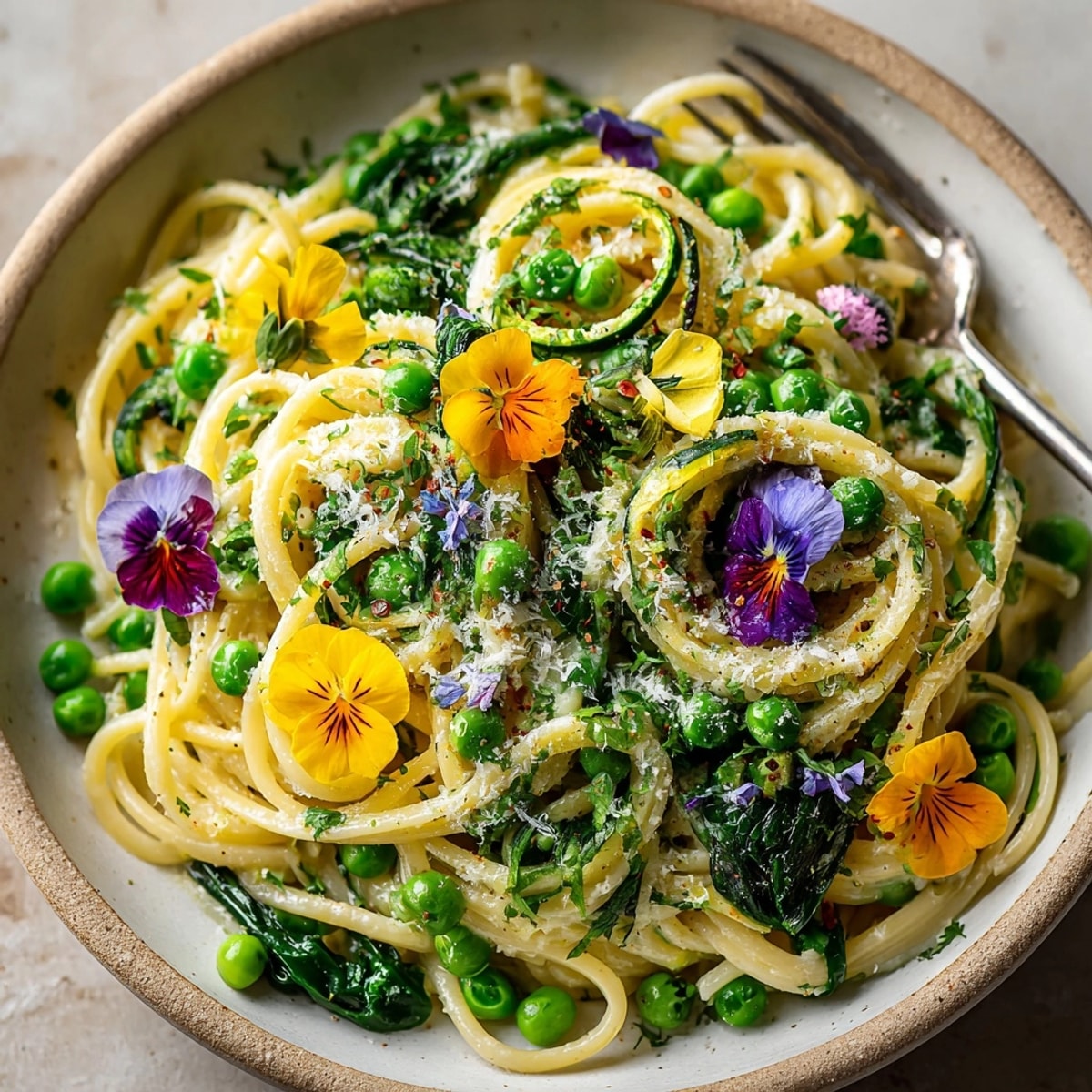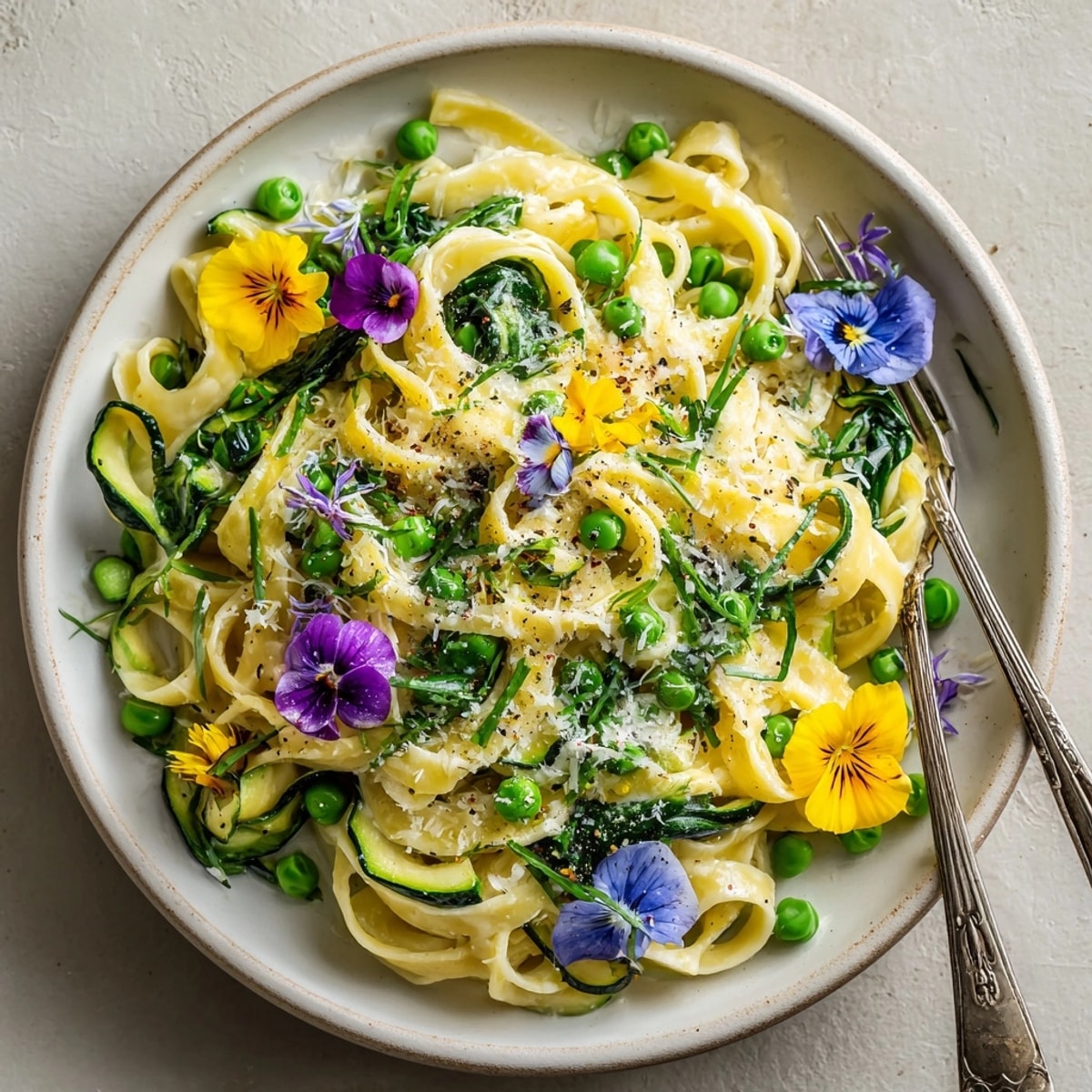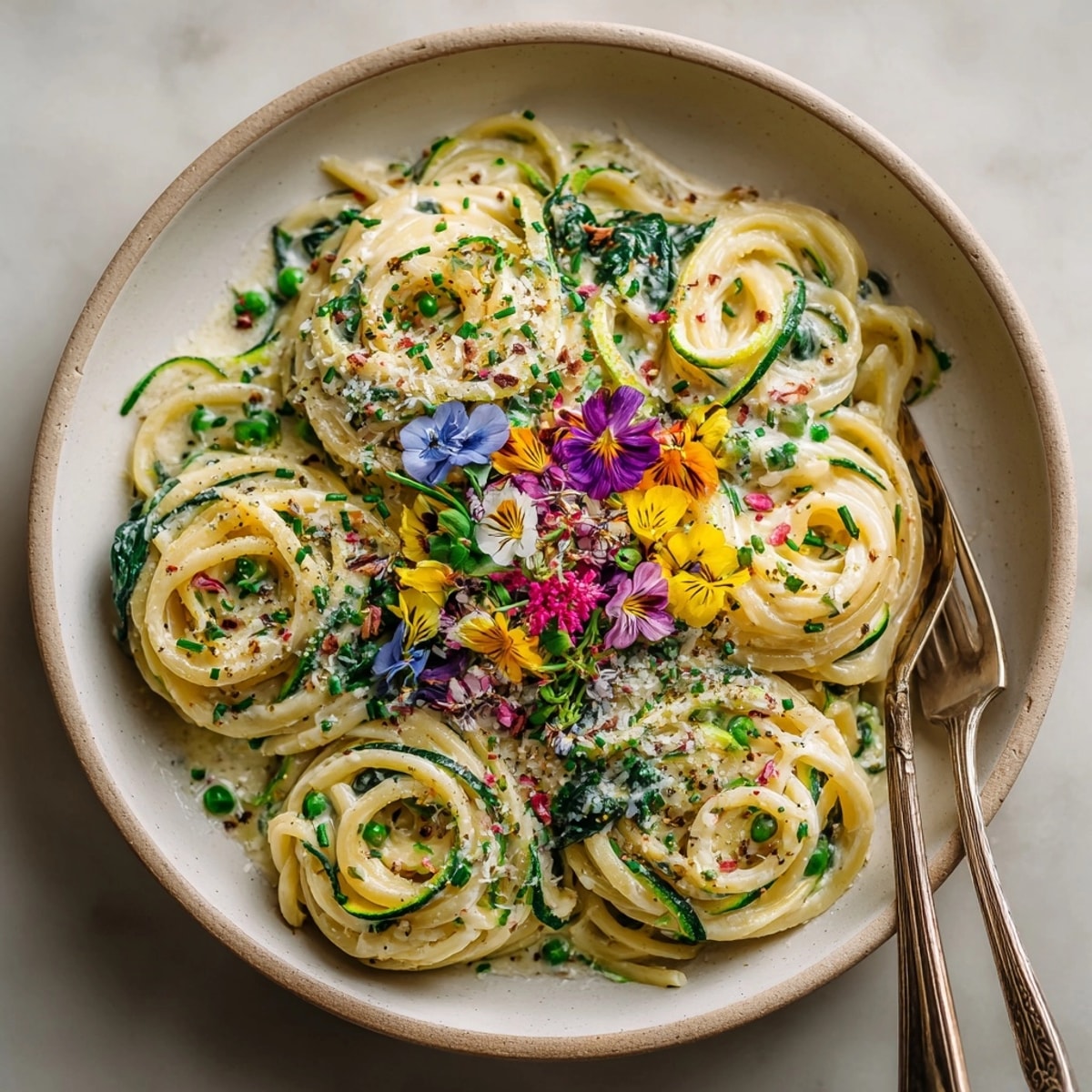 Save
Save This creamy flower crown pasta transforms an ordinary weeknight dinner into an elegant botanical feast. The delicate edible flowers create a stunning visual crown atop silky pasta, while the fresh vegetables and lemon-infused cream sauce provide a perfect balance of richness and brightness. Perfect for special occasions or when you want to elevate your dinner table with minimal effort.
I first created this recipe for my daughter's birthday dinner when she requested something "pretty and magical." The look on her face when I presented this flower-adorned pasta was priceless—now it's our tradition for celebrating spring and special moments.
Ingredients
- Dried linguine or tagliatelle: provides the perfect canvas for the delicate sauce and allows the flowers to stand out visually. Choose high-quality pasta made with durum wheat for the best texture.
- Unsalted butter: creates a rich base for the sauce without overwhelming the delicate floral notes. European-style butter with higher fat content works particularly well.
- Heavy cream: forms the silky foundation of the sauce. Look for cream without additives for the purest flavor.
- Parmesan cheese: adds umami depth and helps thicken the sauce naturally. Freshly grated is essential here rather than pre-grated varieties.
- Lemon zest: brightens the entire dish and complements the floral garnishes. Choose organic lemons with bright yellow skins for the most fragrant oils.
- Baby spinach: wilts beautifully into the sauce adding nutrition and color. Select bright green leaves without any yellowing.
- Zucchini ribbons: create elegant strands that mirror the pasta shape. Use young zucchini for the sweetest flavor.
- Green peas: add pops of sweetness and color throughout the dish. Fresh spring peas are ideal but frozen work wonderfully too.
- Edible flowers: transform this dish from ordinary to extraordinary. Nasturtiums offer a peppery bite while pansies and violets contribute delicate sweetness.
Instructions
- Cook the Pasta:
- Bring a large pot of water to a rolling boil before adding salt—it should taste like sea water. Add pasta and cook until just al dente according to package directions, typically 8-10 minutes. Reserve half a cup of the starchy cooking water before draining, as this liquid gold helps create a silky sauce. Toss drained pasta with a touch of olive oil to prevent sticking while you prepare the sauce.
- Create the Cream Base:
- Melt butter in a wide skillet over medium heat until it begins to foam but not brown. Add minced garlic and cook for exactly one minute, stirring constantly to prevent burning. The garlic should become fragrant and just barely golden. Pour in heavy cream and allow it to come to a gentle simmer—tiny bubbles should form at the edges but never a full boil, which can cause separation.
- Develop the Sauce:
- Add freshly grated Parmesan in small handfuls, stirring constantly to incorporate into the cream. The cheese will melt and thicken the sauce naturally. Sprinkle in lemon zest, which releases its essential oils into the warm sauce. Season thoughtfully with salt and freshly ground black pepper, remembering that Parmesan already contributes saltiness.
- Incorporate Vegetables:
- Add zucchini ribbons first, allowing them to soften slightly for about one minute before adding spinach and peas. The spinach will dramatically reduce in volume as it wilts. Stir gently to coat all vegetables in the creamy sauce while maintaining their vibrant colors and textures. This quick cooking preserves their fresh flavors and nutrients.
- Combine with Pasta:
- Add drained pasta directly to the sauce, using tongs to gently lift and fold everything together. If the sauce seems too thick, add reserved pasta water tablespoon by tablespoon until you achieve a silky consistency that clings to each strand. The starch in this water acts as a natural emulsifier between the butter, cream and cheese.
- Plate and Garnish:
- Twirl pasta into elegant nests on warmed plates using tongs or a carving fork. The presentation is key to showcasing the floral elements. Artfully arrange edible flowers in a crown-like pattern around the pasta mound. Scatter fresh chives and additional lemon zest over the top just before serving to add bright color and fresh flavor notes.
 Pin it
Pin it I discovered the magic of edible flowers years ago when visiting a small Italian village where the chef garnished every plate with seasonal blooms. The nasturtium is my favorite addition to this dish—its peppery flavor provides a surprising counterpoint to the creamy sauce, and its vibrant orange and red hues create the most dramatic visual impact against the pale pasta.
Choosing Edible Flowers
Selecting the right flowers is crucial for both safety and flavor. Only use flowers specifically labeled as edible from reputable sources like specialty grocers, farmers markets or your own unsprayed garden. Common edible varieties include nasturtiums, pansies, violets, calendula petals, bachelor buttons, and herb blossoms like chive flowers. Each brings its own flavor profile—nasturtiums offer a peppery bite similar to arugula, while violets contribute a delicate sweetness. Always introduce new edible flowers gradually if you have allergies or sensitivities.
Seasonal Adaptations
Spring Version Use tender asparagus tips, fresh peas, and early zucchini with violet and pansy flowers for a celebration of spring flavors. Add fresh mint leaves for brightness.
Summer Version Incorporate yellow squash ribbons, cherry tomatoes, and basil with nasturtiums and marigold petals for vibrant summer colors and flavors. A touch of lemon thyme enhances the seasonal brightness.
Fall Version Feature butternut squash ribbons, sage leaves, and toasted walnuts with calendula petals and chrysanthemum flowers for an autumnal twist. Brown butter can replace some of the cream for nuttier depth.
Winter Version Use preserved edible flowers or focus on herbs like rosemary blossoms, paired with winter greens, roasted garlic, and sun-dried tomatoes for a warming cold-weather version.
Flower Selection Guide
Not all pretty blooms belong on your plate. Here's how to navigate the world of edible flowers for this pasta:
Beginner-Friendly Flowers Start with mild-flavored, widely available options like pansies, violets, and herb blossoms such as chives or basil flowers. These are gentle introductions to edible flowers with subtle flavors.
Statement Flowers Nasturtiums create dramatic visual impact with their bright colors and offer a pleasant peppery taste that complements the creamy sauce. Their trumpet shape holds beautifully on the plate.
Flavor-Forward Options Calendula petals provide a saffron-like color and subtle spiciness, while borage flowers taste surprisingly like cucumber, adding an unexpected freshness to each bite.
 Pin it
Pin it The true magic of flower crown pasta lies not just in its beauty but in the conversation it sparks around your table. Food should delight all senses, and this dish celebrates that philosophy perfectly.
Frequently Asked Questions
- → What edible flowers work best as garnish?
Nasturtiums, pansies, violets, and marigold petals are ideal—they offer vibrant color and mild, pleasant flavors.
- → How do you ensure flowers are safe to eat?
Use only organically grown edible flowers from reputable sources and confirm they haven’t been treated with pesticides.
- → Can the dish be made vegan?
Substitute plant-based cream and cheese for dairy ingredients, and use vegan butter to keep flavors rich and creamy.
- → Which herbs pair well with edible-flower pasta?
Fresh chives, basil, and parsley offer delicate enhancements without overpowering the floral notes in the garnish.
- → What is the best pasta shape for this presentation?
Linguine or tagliatelle allow for beautiful twirls and optimal surface area for sauce and flower garnish.
- → How should leftovers be stored?
Keep in an airtight container in the refrigerator for up to two days. Add fresh edible flowers just before serving again.